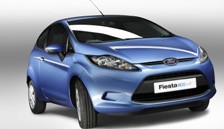Review
Ford executives burned the midnight oil when the time came to choose a fresh name for the latest version of their best-selling small car.
But after prolonged debates, they decided it would be impossible to improve on Fiesta, the name selected for the company’s first front-wheel drive supermini back in 1976.
‘Changing a name is the easy option, but it costs millions of pounds and you need a pretty compelling reason to do it.
‘Volkswagen still uses Passat, even though the latest car is nothing like the original and the MINI shows that if people still like your brand after 50 years, you have an icon.
We didn’t want a repeat of what happened after Toyota ditched the Corolla for the Auris – people still don’t know what that car is,’ said Ford of Britain marketing director Mark Ovenden.
Speaking at the launch of the next-generation Ford supermini, he told Fleet News: ‘We’ve had rigorous meetings over this, but still feel the Fiesta badge is perfect for our product – everybody knows it stands for value and performance and it has become part of the national scene.
After 32 years, one of Britain’s favourite models also deserves to be recognised as the epitome of style in the segment.
On sale now, though not officially launched until mid-October, it is the best-proportioned small Ford yet.
Four Duratec 16-valve petrol engines sized from 1.25 to 1.6 litres will power the Fiesta, along with a 1.4-litre diesel and two 1.6-litre units, one of which has CO2 emissions of 98g/km – the lowest yet achieved by a family car - and boasts road tax exemption plus 76.3mpg combined economy.
As before, three and five-door versions will be offered in Studio, Style, Style+, Zetec, Zetec S, Titanium and Econetic trim.
All offer higher levels of equipment, with the entry-level Studio boasting anti-lock braking, front, side and knee airbags, CD player, central locking and electric mirrors despite costing £155 less than the outgoing version.
‘We’re budgeting for total annual sales to remain the same at 100,000 because the facelift action on the previous version proved to be more successful than we expected.
But customers should expect to pay nearer the sticker price for the new versions because factory support will be at a lower level,’ said Mr Ovenden.
Ford’s first model developed to enter world markets with only minor modifications looks bigger but has almost identical exterior measurements as its predecessor.
Wraparound headlamps, pronounced wheelarch lips and an up-swinging bodyline give it a dynamic appearance.
‘Our research showed that there so many good things about the old model that we set out to improve on a solid foundation.
The supermini segment is highly dependent on styling and value, and we think we have the mix just right,’ said Mr Ovenden.
Behind the wheel
The Fiesta does so many things so well that it sets a fresh benchmark in its class – just as the Focus revitalised the lower-medium market a few years ago.
Despite being 40kg lighter than its predecessor, greater rigidity and quality build allows it to ooze class-above refinement.
Unfortunately, only 1.6-litre petrol and turbodiesel examples were available for testing, but both engines reflected upgrading work by offering greater power output along with enhanced smoothness.
Our Sport model was a delight to take through its classy gearbox as it revved freely. Light controls made it easy to handle and the exhaust produced the right kind of noises at high speed.
But if anything, extra nose weight gave the diesel even better poise through the bends with the car always heading where it was pointed and getting there without fuss.
Flexible enough to pick up smoothly from idle speed in fourth or even fifth gear, the diesel had good mid-range pull and produced remarkably little noise at any rate of progress.
With good cabin room up front, an absorbent ride and neat switchgear, this version seems particularly well suited to long-haul journeys.
Verdict
Ford has developed an excellent little car that is as satisfying to drive as it is attractive. It’s so good steal Focus sales by appealing to buyers who can get by with a smaller rear seat and a less voluminous boot.














